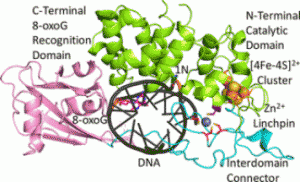Home » Posts tagged 'David Lab'
Tag Archives: David Lab
New Manuscript Published: The Zinc Linchpin Motif in the DNA Repair Glycosylase MUTYH: Identifying the Zn2+ Ligands and Roles in Damage Recognition and Repair.
New Manuscript Published: The Zinc Linchpin Motif in the DNA Repair Glycosylase MUTYH: Identifying the Zn2+ Ligands and Roles in Damage Recognition and Repair.

A recent publication from the David, Siegel and Lim (Academia Sinica, Taiwan) labs (Nuñez et al., JACS, 2018) provides insight into the coordination sphere and critical role of a Zn2+ metal binding site in the DNA repair glycosylase MUTYH. Genome database mining and sequence alignment of MUTYH orthologs, along with computational modeling, identified and supported Zn2+ ligation by four Cys residues. Three of the Cys residues lie in an interdomain connector region unique to mammalian MutY enzymes, while the 4th Cys is located in close proximity to the Fe-S cluster DNA binding domain. The functional consequences of reduced Zn2+ chelation on MUTYH-mediated DNA repair activity evaluated using a battery of in vitro and cell-based assays revealed the importance of Zn-coordination in recognition of the damaged DNA substrate. The critical nature of the “Zinc Linchpin Motif” suggests additional functions unique to higher organisms in damage signaling and crosstalk with other DNA repair pathways.
More information at https://pubs.acs.org/doi/10.1021/jacs.8b06923.
Source:
J. Am. Chem. Soc. 2018, 140, 13260-13271.
Keywords: #Muty #Mutyh #BER #DNA #DNARepair #ZincLinchpinMotif #Zn2+ #8OG #DavidLab #UCDavis
New Manuscript Published: Selective base excision repair of DNA damage by the non‐base‐flipping DNA glycosylase AlkC.
New Manuscript Published: Selective base excision repair of DNA damage by the non‐base‐flipping DNA glycosylase AlkC.
The preservation of genomic integrity performed by DNA repair machinery is crucial for living organisms, and malfunctions in DNA repair machinery can have far-reaching and devastating effects on a cell’s ability to attain precise DNA replication, properly regulate cell differentiation and self-renewal, and to regulate cell growth and apoptosis, among other important cellular functions. Mutations of critical residues in DNA repair proteins can drastically reduce DNA repair capability in cells, allowing for a build-up of genomic mutations. Inherited variants in DNA repair proteins such as glycosylase MUTYH have been linked to a predisposition to tumors in patients with disease MUTYH Associated Polyposis (MAP). The David Lab is interested in delineating DNA repair mechanisms to help shed light on the etiology of cancer and other diseases, providing mechanistic and structural information that may be used, for example, to design drug molecules targeting DNA repair proteins.
New work from the David Lab examined the selective base excision repair of DNA damage by the non-base-flipping DNA glycosylase AlkC, which primarily targets alkylated-DNA damage product N3-methyladenine (3mA). This work details how AlkC selects for and excises 3mA with its non-base-flipping mechanism. The authors carried out a comprehensive phylogenetic, biochemical, and structural comparison of AlkC and AlkD proteins for comparison, which shows, notably, characteristics important for substrate specificity and why bulkier substrates are not preferred. Interestingly, AlkC’s excision mechanism involves using HEAT-like repeat domains and in most cases Ig-like domains to introduce a kink in the target DNA, helping to expose the target nucleobase, allowing for subsequent insertion of the enzyme active site to excise its target.
Click here to read more about AlkC’s non-base-flipping mechanism.
Source:
Just Accepted Manuscript: Structure Activity Relationships Reveal Key Features of 8-Oxoguanine:Adenine Mismatch Detection by the MutY DNA Glycosylase
7/20/2017
The recently accepted manuscript, Structure Activity Relationships Reveal Key Features of 8-Oxoguanine:Adenine Mismatch Detection by the MutY DNA Glycosylase, was accepted for publication in ACS Chemical Biology.
MutY, remarkably, is able to specifically recognize and initiate repair of target OG:A mismatches from among a vast sea of natural DNA. To help reveal molecular features of OG that are critical for MutY recognition, this work explored the effects of systematic OG:A substrate alterations on MutY recognition in a cellular context. OG analogs were synthesized, assembled into OG:A modified oligonucleotides, and structure activity relationships were investigated using binding and cellular repair assays. Read the article to find out more about how specific OG modifications effect MutY glycosylase activity. Click here for the article: http://pubs.acs.org/doi/abs/10.1021/acschembio.7b00389.
Keywords: #Muty #DNA #DNARepair #BER #ModifiedNucleosides #Enzymes #8OG #DavidLab #UCDavis #glycosylase
Congratulations to Doug Banda and coworkers!
5/31/2017
Congratulations to David Lab authors Doug, Nicole, Michael, and Katie on their recently released article, “Repair of 8-OXOG:A Mismatches by the MUTYH Glycosylase: Mechanisms, Metals and Medicine,” in Free Radical Biology and Medicine! The final version of the article is now available online.
Link to their new article here: https://authors.elsevier.com/a/1V8Lr3AkHAI6DS.
